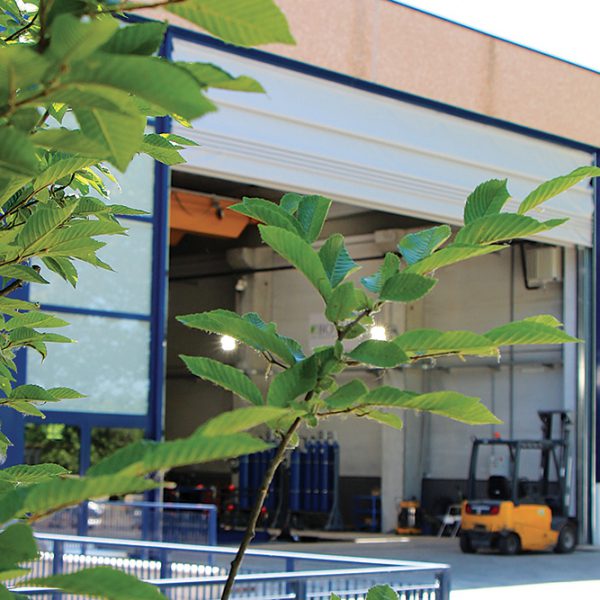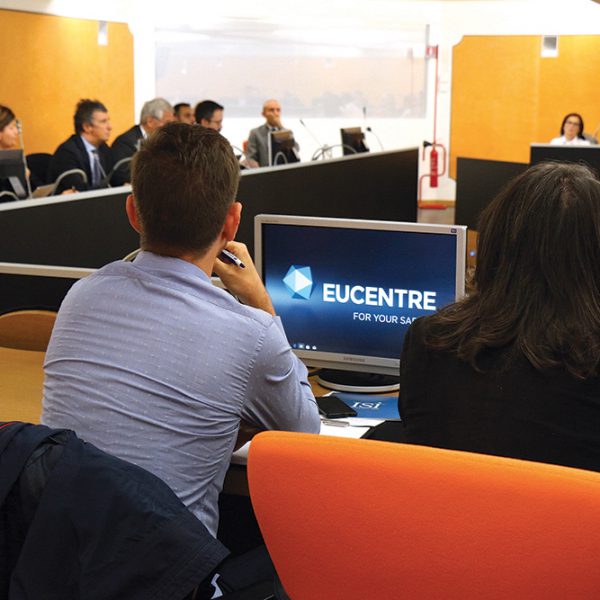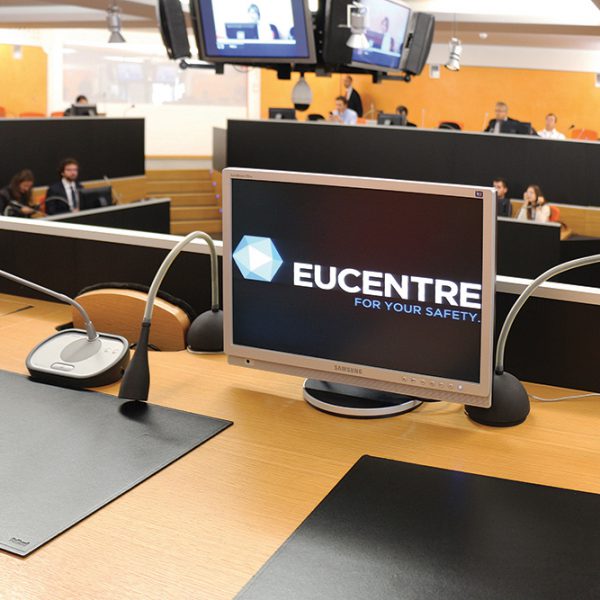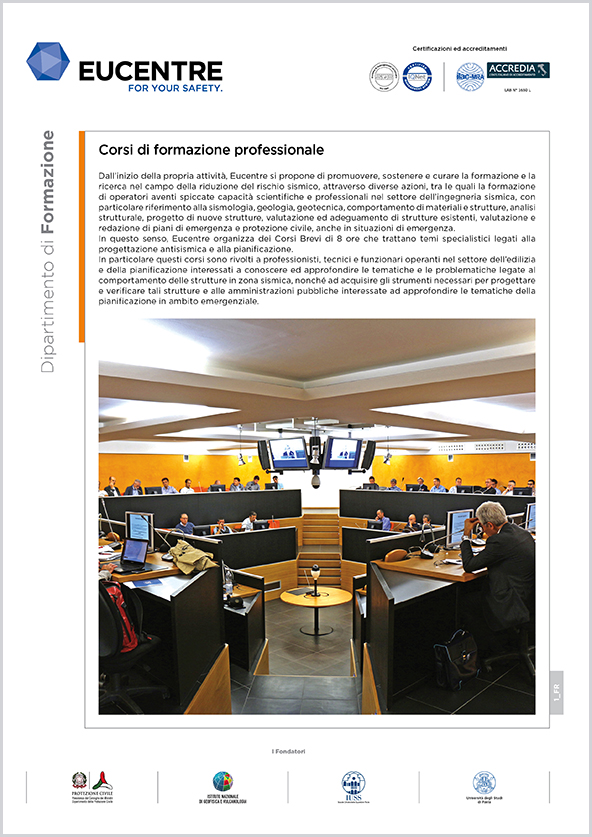Dipartimento di Formazione
Corsi di formazione professionale
Dall’inizio della propria attività, Eucentre si propone di promuovere, sostenere e curare la formazione e la ricerca nel campo della riduzione del rischio sismico, attraverso diverse azioni, tra le quali la formazione di operatori aventi spiccate capacità scientifiche e professionali nel settore dell’ingegneria sismica, con particolare riferimento alla sismologia, geologia, geotecnica, comportamento di materiali e strutture, analisi strutturale, progetto di nuove strutture, valutazione ed adeguamento di strutture esistenti, valutazione e redazione di piani di emergenza e protezione civile, anche in situazioni di emergenza.
In questo senso, Eucentre organizza dei Corsi Brevi di 8 ore che trattano temi specialistici legati alla progettazione antisismica e alla pianificazione.
In particolare questi corsi sono rivolti a professionisti, tecnici e funzionari operanti nel settore dell’edilizia e della pianificazione interessati a conoscere ed approfondire le tematiche e le problematiche legate al comportamento delle strutture in zona sismica, nonché ad acquisire gli strumenti necessari per progettare e verificare tali strutture e alle amministrazioni pubbliche interessate ad approfondire le tematiche della pianificazione in ambito emergenziale.

Titoli di alcuni dei Corsi e Seminari erogati dal 2004 al 2019:
- Analisi, modellazione e verifica di strutture in legno;
- Analisi e modellazione di strutture monumentali: edifici storici, volte e cupole;
- Valutazione della vulnerabilità e del danno di beni culturali;
- Tamponamenti in muratura soggetti ad azione sismica: dalla sperimentazione alla progettazione;
- Progettazione sismica di strutture in acciaio;
- Analisi, modellazione e verifica di strutture in acciaio;
- I collegamenti nelle costruzioni di acciaio in zona sismica;
- Le strutture composte acciaio-calcestruzzo;
- Analisi, modellazione, verifica ed adeguamento in strutture ed infrastrutture in cemento armato;
- Analisi, modellazione e verifica di edifici esistenti in cemento armato;
- Progettazione agli spostamenti di edifici in cemento armato;
- Materiali innovativi per le strutture: calcestruzzo ad alte prestazioni, barre, profili e lamine in FRP;
- Progettazione sismica di strutture isolate;
- Valutazione della vulnerabilità sismica di strutture ed elementi non strutturali tramite metodi semplificati;
- Sismabonus;
- Sisma ed elementi non strutturali: approcci, codici, verifiche e prestazioni;
- Scaffalature metalliche industriali;
- Analisi e verifica sismica di gusci e serbatoi;
- Analisi della vulnerabilità sismica dei serbatoi in acciaio;
- Analisi, modellazione, verifica ed adeguamento di ponti;
- Progettazione e valutazione di capannoni industriali ed edifici prefabbricati pluripiano in zona sismica;
- Progettazione di interventi di adeguamento di capannoni prefabbricati;
- Tecniche sperimentali e indagini diagnostiche per la valutazione rapida delle strutture;
- Metodologie classiche ed innovative di adeguamento delle strutture;
- Modellazione e analisi non lineare delle strutture;
- Meccanica non-lineare delle strutture: metodi, modelli ed applicazioni;
- Identificazione dinamica e monitoraggio strutturale in continuo basato sulle vibrazioni;
- Effetti delle vibrazioni sulle strutture e sulle persone: tecniche di misura e metodi di valutazione;
- Azioni estreme sulle costruzioni;
- La direzione dei lavori, il collaudo statico in corso d’opera delle opere strutturali e le prove di carico sulle strutture;
- Analisi probabilistica di pericolosità sismica;
- Pericolosità, rischio sismico e codici per le costruzioni;
- Codici normativi internazionali per le strutture;
- Selezione dell’input sismico: principi, metodi e strumenti;
- Pericolosità sismica e terremoti di progetto: strategie di selezione dell’input sismico per l’analisi non lineare delle strutture;
- Dissesti delle costruzioni, crolli ed elementi di ingegneria forense;
- Il dissesto idrogeologico nello scenario geologico italiano;
- Progettazione sismica di opere fondazionali;
- Modellazione numerica avanzata in ingegneria geotecnica;
- Rischio idrogeologico: interventi di mitigazione strutturali e non strutturali di fenomeni franosi;
- Building Information Modeling: Gli strumenti e le procedure per la digitalizzazione della commessa.
[easy-social-share buttons=”facebook,twitter,google,pinterest,linkedin,whatsapp” counters=0 style=”icon” point_type=”simple”]
 Eucentre è una Fondazione di diritto privato senza scopo di lucro che persegue una missione di ricerca, formazione e erogazione di servizi nel settore dell’ingegneria sismica e, più in generale, dell’ingegneria della sicurezza
Eucentre è una Fondazione di diritto privato senza scopo di lucro che persegue una missione di ricerca, formazione e erogazione di servizi nel settore dell’ingegneria sismica e, più in generale, dell’ingegneria della sicurezza  Eucentre promuove Scienza, Ricerca e Innovazione a beneficio della collettività, offrendo metodologie mirate e soluzioni concrete per prevenzione, sicurezza e resilienza. Collabora con istituzioni e imprese, diffondendo competenze orientate al vantaggio comune.
Eucentre promuove Scienza, Ricerca e Innovazione a beneficio della collettività, offrendo metodologie mirate e soluzioni concrete per prevenzione, sicurezza e resilienza. Collabora con istituzioni e imprese, diffondendo competenze orientate al vantaggio comune. Tavole vibranti
Tavole vibranti Altri sistemi di prova
Altri sistemi di prova Eucentre conduce attività di ricerca su ingegneria sismica e riduzione del rischio, attraverso prove di laboratorio e analisi numeriche, per migliorare il comportamento sismico di strutture e terreni e sviluppare tecniche innovative di consolidamento antisismico.
Eucentre conduce attività di ricerca su ingegneria sismica e riduzione del rischio, attraverso prove di laboratorio e analisi numeriche, per migliorare il comportamento sismico di strutture e terreni e sviluppare tecniche innovative di consolidamento antisismico. La Fondazione promuove attività formative diversificate e di alta qualità, rivolte a contesti accademici e professionali, con programmi e iniziative costantemente aggiornati e innovativi per rispondere alle esigenze in continua evoluzione del settore e della società
La Fondazione promuove attività formative diversificate e di alta qualità, rivolte a contesti accademici e professionali, con programmi e iniziative costantemente aggiornati e innovativi per rispondere alle esigenze in continua evoluzione del settore e della società  Eucentre assicura una comunicazione per informare istituzioni, professionisti e cittadini sulle attività e i progetti in corso, con l’obiettivo di diffondere contenuti e conoscenze utili e accessibili a tutti. Contribuisce a promuovere una cultura della prevenzione e della resilienza, condivisa e consapevole.
Eucentre assicura una comunicazione per informare istituzioni, professionisti e cittadini sulle attività e i progetti in corso, con l’obiettivo di diffondere contenuti e conoscenze utili e accessibili a tutti. Contribuisce a promuovere una cultura della prevenzione e della resilienza, condivisa e consapevole.




